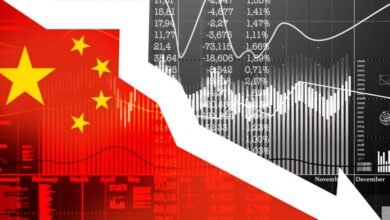Inflation Figures Exceed Expectations

Inflation Figures Exceed Expectations
In an ever-evolving economic landscape, many were caught off guard when the latest inflation figures exceed expectations, marking a surge that defied forecasts. As we dive into understanding this inflation rate surge, it’s crucial to recognize the key drivers behind these rising inflation rates. With an unexpected inflation increase impacting both wallet and economy, the implications extend far beyond mere percentages. So, what are the causes of inflation figures exceeding expectations? And more importantly, what is the impact of higher-than-expected inflation on the economy? This post will not only dissect the rising inflation data but also provide guidelines on how to interpret inflation figures that exceed expectations and offer practical strategies to adapt. Brace yourself for an insightful journey into the intricacies of higher than expected inflation and learn how to navigate the economy amidst these turbulent times.
Understanding the Recent Inflation Surge
In today’s rapidly evolving economic landscape, inflation figures exceed expectations more frequently than anticipated. This trend leaves many wondering, “What is driving this inflation rate surge?” To effectively navigate this phenomenon, it is crucial to first understand the underlying dynamics.
What is Inflation?
Before diving into its recent surge, let’s clarify what inflation is. In simple terms, inflation refers to the general increase in prices over time, which reduces the purchasing power of money. This means you need more money today to buy the same goods and services you could have bought for less in the past.
Inflation Figures Exceed Expectations Key Indicators of Rising Inflation Rates
Crucial indicators to monitor rising inflation data include:
- Consumer Price Index (CPI): A measure that examines the average change over time in the prices paid by urban consumers for a market basket of consumer goods and services.
- Producer Price Index (PPI): This reflects the average change in selling prices received by domestic producers for their output.
- Core Inflation Rate: Excludes the prices of food and energy due to their volatility, providing a clearer view of long-term trends.
| Indicator | Description |
|---|---|
| Consumer Price Index | Measures the overall change in consumer prices. |
| Producer Price Index | Reflects changes in the selling prices received by producers in the economy. |
| Core Inflation Rate | Excludes volatile items like food and energy to reveal the underlying trends. |
Causes of Inflation Figures Exceeding Expectations
Multiple factors contribute to inflation surpassing forecasts:
- Supply Chain Disruptions: Interruptions in global supply chains can lead to shortages of goods, driving up prices.
- Increased Demand: Surges in consumer spending, particularly after periods of economic lull, can cause a spike in prices.
- Monetary Policies: Central banks’ policies regarding interest rates and money supply can also precipitate inflation.
Why It Matters
Understanding why inflation figures exceed expectations is vital for several reasons:
- Economic Planning: Businesses and governments rely on accurate inflation forecasts for budget planning and policy-making.
- Investment Decisions: Investors adjust their portfolios based on anticipated inflation trends to safeguard returns.
- Household Budgets: For families, higher-than-expected inflation affects the cost of living, influencing household budgeting and saving strategies.
By grasping the fundamentals of this unexpected inflation increase, you can better prepare for its impacts and make more informed financial decisions. Stay informed, stay prepared, and navigate the complexities of an inflating economy with clarity and confidence!
Inflation Figures Exceed Expectations Why Inflation Figures Surpassed Forecasts
In an era where predicting economic trends is akin to navigating a ship through uncharted waters, many are left wondering why recent inflation figures exceed expectations. Let’s delve into the factors that led to inflation surpassing forecasts and understand what drives rising inflation rates beyond anticipated levels.
First and foremost, several unforeseen events have significantly impacted the global economy, creating a ripple effect on inflation. Here are some key drivers:
- Supply Chain Disruptions: The pandemic severely disrupted manufacturing and shipping channels worldwide. As demand surged with the global reopening, supply chains struggled to catch up, driving prices higher than anticipated.
- Energy Prices: Energy costs, crucial for production and transportation, have spiked unexpectedly. This surge directly contributes to the overall rise in inflation.
- Labor Market Shocks: Labor shortages and wage increases have outstripped forecasts. With businesses competing for a limited workforce, increased wages are being passed onto consumers, inflating prices further.
Causes of inflation figures exceeding expectations can be broken down into a few primary categories:
| Cause | Explanation |
|---|---|
| Supply Chain Bottlenecks | Disruptions in manufacturing and shipping. |
| Commodity Price Surge | Increased costs for raw materials and energy. |
| Labor Market Changes | Wage hikes due to labor shortages. |
| Government Stimulus | Increased consumer spending from fiscal policies. |
The unpredictability of these combined factors makes accurate forecasting challenging for economists. Central banks and policymakers need to consider these elements when setting monetary policies to manage higher than expected inflation.
By understanding these key drivers, individuals and businesses can better anticipate market movements and prepare for rising inflation data. Staying informed and adaptable is essential to navigate the complexities of today’s economic landscape and mitigate the impact of unforeseen financial trends.
Inflation Figures Exceed Expectations Key Drivers Behind the Rising Inflation Rates
Inflation Figures Exceed Expectations—a phrase that has significant economic implications. But what exactly is propelling these rising inflation rates? Understanding the factors at play is essential for businesses, consumers, and policymakers alike.
Supply Chain Disruptions
One major contributor is the disruption of global supply chains. COVID-19 initiated a cascading series of delays and bottlenecks that have persisted well into 2023. Shipping costs soared, and the availability of essential materials dwindled. With goods harder to come by, prices naturally increased.
- Shipping Delays: Longer transit times and port congestions have driven up costs.
- Shortage of Materials: Key resources like semiconductors and raw materials became scarce.
Labor Market Imbalances
The labor market is another crucial factor. The unexpected inflation increase has been exacerbated by wage growth and labor shortages. Companies across various sectors have raised wages to attract talent, and these additional costs often get passed on to consumers.
- Wage Inflation: Rising salaries in sectors like technology and healthcare.
- Worker Demand: High demand for skilled labor pushing wages upward.
Increased Consumer Demand
Economic recovery efforts post-pandemic saw a rapid surge in consumer spending. Stimulus checks, savings accumulated during lockdowns, and a strong appetite for goods and services all played their parts. This spike in demand, against a backdrop of supply restrictions, leads to higher prices.
- Government Stimulus: Financial aid packages injected significant spending power into the economy.
- Pent-Up Demand: Consumers eager to spend after prolonged periods of restricted activity.
Inflation Figures Exceed Expectations Comparing 2022 and 2023 Inflation Rates
| Year | Inflation Rate (%) | Supply Chain Disruptions | Wage Growth (%) | Consumer Spending Increase |
|---|---|---|---|---|
| 2022 | 6.5 | High | 4.0 | Moderate |
| 2023 | 8.2 | Very High | 5.5 | High |
Energy Prices
Energy prices have also surged, significantly impacting transportation and production costs. As crude oil prices rise, the repercussions are felt across the entire economy, from the cost of fuel at the pump to heating bills and beyond.
- Crude Oil: Price hikes due to global geopolitical tensions.
- Transportation Costs: Increased fuel costs impacting logistics.
These key drivers offer a comprehensive understanding of why inflation figures exceed expectations and underscore the complexity of rising inflation rates. It’s clear that multiple interconnected factors contribute to the inflation rate surge, affecting all aspects of the economy. Here, vigilance and strategy are paramount to navigate these turbulent times.
How Unexpected Inflation Increase Impacts Everyday Life
When we hear about inflation figures exceeding expectations, it might seem like abstract economic jargon. However, this unexpected inflation increase can deeply affect our day-to-day experiences and financial well-being. Let’s break down the impact of higher-than-expected inflation on the economy by looking at how it influences various aspects of daily life.
Price of Goods and Services
One of the most immediate and noticeable effects of rising inflation rates is the increase in the cost of goods and services:
- Groceries: Basic items like bread, milk, and vegetables become more expensive.
- Utilities: Your monthly utility bills might see a spike.
- Transportation: Fuel prices may rise, affecting travel and commuting costs.
Purchasing Power
Our money doesn’t stretch as far:
- With prices rising, the same amount of money buys fewer goods and services.
- Savings may erode faster if they’re not earning interest that keeps up with inflation.
Wage Adjustments
Salaries often don’t adjust immediately:
- Employees may find their salary doesn’t go as far as it used to.
- Negotiating higher wages becomes crucial but challenging.
Interest Rates and Borrowing
Interest rates typically rise to combat inflation:
- Loans: Higher interest rates make loans more expensive.
- Mortgages: Monthly payments on variable-rate mortgages could increase.
Savings and Investments
Inflation can both positively and negatively impact savings and investments:
- Savings Accounts: Higher interest rates may provide better returns.
- Stocks and Bonds: Market volatility can increase, impacting investment values.
| Impact Area | Description |
|---|---|
| Groceries | Prices for daily essentials rise, making it harder to keep up with budget constraints. |
| Utilities | Utility bills skyrocket, straining monthly expenses. |
| Transportation | Increased fuel prices affect commuting and travel costs. |
| Purchasing Power | Money’s capacity to buy goods diminishes. |
| Wage Adjustments | Salaries may lag behind inflation, reducing real income. |
| Loans and Mortgages | Loans become costlier as interest rates climb. |
| Savings and Investments | Greater market volatility may affect returns on savings and investments. |
By understanding these effects, individuals can better navigate and adapt to the inflation rate surge. It’s crucial to stay informed and proactive in managing our finances amidst rising inflation data. Keep an eye on economic indicators, and consider seeking financial advice to mitigate the impact on your everyday life.
Inflation Figures Exceed Expectations Analyzing the Economic Effects of Higher-Than-Expected Inflation
The recent inflation figures exceeding expectations have grabbed headlines and caused widespread concern. Understanding the Impact of higher-than-expected inflation on the economy can help us navigate these turbulent times effectively. Here’s a closer look at how this unexpected surge influences various economic aspects:
1. Purchasing Power and Consumer Spending:
- Reduced Purchasing Power: As inflation surpasses forecasts, the purchasing power of money diminishes. This means consumers get less for their money.
- Decreased Consumption: With rising inflation rates, consumers may cut back on non-essential purchases, leading to a reduction in overall consumer spending.
2. Business Operations:
- Increased Costs: Higher-than-expected inflation drives up the cost of raw materials and labor, squeezing profit margins.
- Pricing Strategies: Businesses might increase prices to compensate for higher costs, potentially leading to a decrease in sales volume.
3. Employment and Wages:
- Wage Adjustments: Companies may face pressure to increase wages to match the rising cost of living.
- Employment Cuts: To mitigate increased expenses, some businesses may resort to downsizing, leading to higher unemployment rates.
4. Investment and Savings:
- Impact on Savings: Rising inflation rates erode the real value of savings, affecting individual financial plans.
- Investment Patterns: Investors might shift their portfolios towards assets that traditionally perform better during inflation rate surge periods, such as real estate and commodities.
Here’s a quick comparison table to enhance your understanding:
| Aspect | Impact of Higher-Than-Expected Inflation |
|---|---|
| Purchasing Power | Reduced, leading to decreased consumer spending |
| Business Costs | Increased costs, tighter profit margins |
| Employment | Wage pressures, possible job cuts |
| Investment | Shift towards inflation-resistant assets |
By carefully analyzing these factors, we can better interpret inflation figures that exceed expectations and navigate their complexities. Remember, armed with the right knowledge, we can turn challenges into opportunities even amidst an unexpected inflation increase.
Lets’ continue to stay informed, adapted, and proactive in facing the economic dynamics that these inflation figures exceeding expectations bring. Together, we can ride through these waves of change resiliently!
Evaluating the Causes of Inflation Figures Exceeding Expectations
The recent inflation figures exceeding expectations have certainly raised eyebrows among economists and everyday individuals alike. To understand this phenomenon, it’s crucial to delve into the core factors driving these rising inflation rates.
Supply Chain Disruptions
One of the primary causes of inflation figures exceeding expectations is the significant disruption in global supply chains. The aftermath of the COVID-19 pandemic left many industries scrambling to fulfill pent-up consumer demand. This mismatch between supply and demand has led to price spikes across various sectors, from electronics to groceries.
Energy Prices Soar
Another key driver behind the unexpected inflation increase is the surge in energy prices. From rising oil prices to increased costs of natural gas, these energy components have a direct impact on transportation and manufacturing sectors. Consequently, the cost of goods rises, translating into higher consumer prices.
Labor Market Tensions
Labor shortages and the quest for higher wages have also played a role in the inflation rate surge. As companies compete to attract and retain workers, they are compelled to increase wages, which partially translates into higher prices for goods and services.
Comparison Table: Key Drivers of Inflation
| Key Driver | Impact Area | Result |
|---|---|---|
| Supply Chain Disruptions | Manufacturing & Retail | Elevated production costs |
| Energy Price Increase | Transportation & Utilities | Higher operational expenses |
| Labor Market Tensions | Employment & Services | Increased wages and service costs |
Inflation Figures Exceed Expectations Monetary Policy Adjustments
Lastly, central banks’ monetary policies and fiscal stimulus packages have influenced higher than expected inflation. While these interventions were essential to economic recovery, they have also increased the money supply, contributing to inflation.
The impact of higher-than-expected inflation on the economy extends beyond these immediate causes. It affects purchasing power, leads to market volatility, and can spur interest rate hikes. By understanding these causes, we can better navigate and adapt to this challenging economic landscape.
Guidelines for Interpreting Inflation Figures That Exceed Projections
When inflation figures exceed expectations, it can send ripples through the economy and personal finances. Understanding how to interpret this unexpected inflation increase is crucial for making informed decisions. To help you discern the significance of these numbers, consider the following guidelines:
Key Considerations
- Context Matters:
- Historical Trends: Compare current data with historical inflation rates to see if this is an anomaly or part of a long-term trend.
- Economic Indicators: Look at other indicators like employment rates, GDP growth, and consumer spending to paint a comprehensive picture.
- Break Down the Data:
- Consumer Price Index (CPI): Analyze the CPI to understand which categories are driving the rise, such as food, housing, or energy.
- Core Inflation: Focus on core inflation, which excludes volatile items like food and energy, for a clearer view of underlying inflation trends.
- Economic Impact:
- Purchasing Power: Determine how higher-than-expected inflation affects the real value of money and savings.
- Interest Rates: Consider how central banks might react. Rising inflation often leads to higher interest rates to curb spending.
- Short-Term vs. Long-Term:
- Temporary Spikes: A single month’s high number might not be as concerning if it is expected to be short-lived.
- Sustained Increase: Ongoing rises in the inflation rate surge can indicate deeper economic issues.
Practical Approach
| Aspect | Consideration |
|---|---|
| Historical Trends | Long-term vs. Short-term |
| Economic Indicators | Employment, GDP, Consumer Spending |
| CPI Components | Food, Housing, Energy |
| Core Inflation | Excluding Volatile Items |
| Interest Rates | Central Bank Policies |
| Purchasing Power | Real Value of Money |
By understanding these aspects, you can better grasp the causes and implications of inflation surpassing forecasts. Staying informed and considering the broader context will empower you to make savvy financial decisions amidst rising inflation data.
Next Steps
- Stay Updated: Regularly check economic reports and forecasts.
- Adjust Budgets: Make proactive adjustments to personal and business budgets in anticipation of ongoing changes.
- Seek Advice: Financial advisors can provide personalized strategies to mitigate the effects of higher than expected inflation.
Embrace these guidelines to navigate through times of inflation figures exceeding expectations with confidence and control. This proactive approach will help you stay ahead in an ever-changing economic landscape.
Strategies to Adapt to Rising Inflation Data
In the face of rising inflation data, staying proactive and adjusting your financial strategies can make a significant difference. Here are actionable steps you can take to safeguard your finances and navigate the waters of an unexpected inflation increase successfully:
1. Diversify Your Investments
One of the most effective ways to protect your assets against inflation figures exceeding expectations is by diversifying your investment portfolio. Consider including:
- Stocks and Bonds: Historically, stocks tend to offer higher returns that can outpace inflation.
- Real Estate: Property values and rental income often rise with inflation.
- Commodities: Gold, silver, and other commodities frequently appreciate when inflation rates surge.
2. Budget Adjustment and Spending Control
When encountering higher than expected inflation, revising your household budget is crucial. Focus on:
- Essential Expenses: Prioritize necessities such as food, utilities, and housing.
- Discretionary Spending: Be mindful of non-essential spending; prioritize savings and emergency funds.
3. Increase Your Income Streams
If possible, look for ways to boost your income. This could involve:
- Side Gigs: Freelance work or part-time jobs can supplement your primary income.
- Upskill: Acquire new skills that can lead to higher-paying roles or opportunities.
4. Debt Management
Inflation affects interest rates, and managing debt becomes critical. Consider:
- Fixed-Rate Loans: These are generally more favorable than variable-rate alternatives during inflationary periods.
- Pay Down Debt: Reducing existing debts can alleviate financial stress as the cost of servicing debt rises.
Inflation Figures Exceed Expectations Key Points for Adjusting Financial Strategies
| Strategy | Details |
|---|---|
| Investment Diversification | Mix stocks, real estate, and commodities to hedge against inflation. |
| Budget Review | Focus on necessary expenses, minimize discretionary spending. |
| Increase Income | Take on side gigs, freelance work, or upskill to earn more. |
| Debt Management | Opt for fixed-rate loans and pay down existing debts. |
Conclusion
Staying vigilant and adapting your financial habits in response to higher-than-expected inflation is essential. By diversifying investments, adjusting your budget, finding additional income sources, and managing debt wisely, you can mitigate the adverse effects and maintain financial stability. Embrace these strategies and stay confident amidst the inflation rate surge.
Navigating the Economy Amidst Surging Inflation Rates
Inflation figures exceed expectations — a headline that has become all too familiar recently. The inflation rate surge has left many grappling with rising costs and an uncertain financial future. However, understanding how to navigate the economy amidst these surging inflation rates can empower you to make informed decisions and protect your financial well-being.
Assess Your Current Financial Situation
To begin with, take a close look at your personal finances. Analyze your expenses, categorize your spending, and identify areas where you can cut back. Keep an eye on non-essential expenditures that can be temporarily reduced or eliminated.
Build a Resilient Budget
Creating a budget that accounts for inflation is crucial. Here are some tips to build a resilient budget:
- Prioritize necessities: Focus on essential items like housing, food, and healthcare.
- Adjust for rising prices: Increase allocations for categories where prices are rising, such as groceries and utilities.
- Emergency fund: Ensure you have an emergency fund to cover unexpected costs.
Invest Wisely
Investing can be a powerful tool to combat the effects of higher-than-expected inflation. Consider diversifying your investment portfolio to include assets that historically perform well during inflationary periods, such as:
- Commodities: Gold, silver, and other commodities often retain value.
- Real estate: Property investments can serve as a hedge against inflation.
- Inflation-protected securities: Treasury Inflation-Protected Securities (TIPS) could be beneficial.
Stay Informed
Stay updated on economic trends and rising inflation data. Reliable sources like government reports, financial news, and economic analyses can provide valuable insights. Understanding the causes of inflation figures exceeding expectations can prepare you for potential fluctuations.
Inflation Figures Exceed Expectations Seek Professional Advice
Consulting with a financial advisor can offer personalized guidance tailored to your situation. They can help you interpret inflation figures that exceed expectations, understand their impact on your investments, and devise strategies to safeguard your wealth.
Table: Comparison of Investment Options During Inflation
| Investment Option | Pros | Cons |
|---|---|---|
| Commodities | Tangible assets, often value-preserving | Volatile market trends |
| Real Estate | Potential for appreciation, rental income | High entry cost, illiquidity |
| Inflation-Protected Securities | Guaranteed to keep pace with inflation | Lower returns compared to stocks |
Inflation Figures Exceed Expectations Adapt and Thrive
Finally, remember that adapting to higher than expected inflation is a continuous process. Stay flexible, reassess your strategies regularly, and be prepared to make adjustments as necessary. By taking proactive steps, you can successfully navigate the economy amidst surging inflation rates and secure a more stable financial future.
These strategies empower you to face economic challenges confidently, ensuring that you remain resilient in an era marked by inflation surpassing forecasts.



